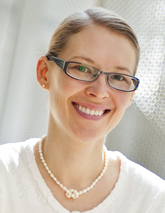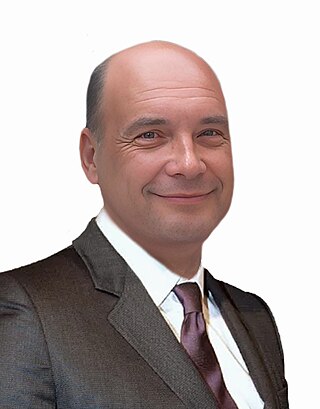Naomi J. Halas is the Stanley C. Moore Professor in Electrical and Computer Engineering, and professor of biomedical engineering, chemistry and physics at Rice University. She is also the founding director of Rice University Laboratory for Nanophotonics, and the Smalley-Curl Institute. She invented the first nanoparticle with tunable plasmonic resonances, which are controlled by their shape and structure, and has won numerous awards for her pioneering work in the field of nanophotonics and plasmonics. She was also part of a team that developed the first dark pulse soliton in 1987 while working for IBM.

A metamaterial is any material engineered to have a property that is rarely observed in naturally occurring materials. They are made from assemblies of multiple elements fashioned from composite materials such as metals and plastics. These materials are usually arranged in repeating patterns, at scales that are smaller than the wavelengths of the phenomena they influence. Metamaterials derive their properties not from the properties of the base materials, but from their newly designed structures. Their precise shape, geometry, size, orientation and arrangement gives them their smart properties capable of manipulating electromagnetic waves: by blocking, absorbing, enhancing, or bending waves, to achieve benefits that go beyond what is possible with conventional materials.
Federico Capasso, a prominent applied physicist, was one of the inventors of the quantum cascade laser during his work at Bell Laboratories. He is currently on the faculty of Harvard University. He has co-authored over 450 papers, edited four volumes, and holds over 60 US patents.
Nanophotonics or nano-optics is the study of the behavior of light on the nanometer scale, and of the interaction of nanometer-scale objects with light. It is a branch of optics, optical engineering, electrical engineering, and nanotechnology. It often involves dielectric structures such as nanoantennas, or metallic components, which can transport and focus light via surface plasmon polaritons.

Nader Engheta is an Iranian-American scientist. He has made pioneering contributions to the fields of metamaterials, transformation optics, plasmonic optics, nanophotonics, graphene photonics, nano-materials, nanoscale optics, nano-antennas and miniaturized antennas, physics and reverse-engineering of polarization vision in nature, bio-inspired optical imaging, fractional paradigm in electrodynamics, and electromagnetics and microwaves.

Allan Dawson Boardman was a British physicist, known for his work on surface plasmons and guided wave optics, especially nonlinear waves, solitons, magneto-optics and negative refracting metamaterials. He was a theorist and numerical analyst in these areas, especially magneto-optics and metamaterials. In 2006 he was made a fellow of the Optical Society of America for his contributions in these fields and for "exemplary leadership and service to the optics community".

Vladimir (Vlad) M. Shalaev is a Distinguished Professor of Electrical and Computer Engineering and Scientific Director for Nanophotonics at Birck Nanotechnology Center, Purdue University.
Satoshi Kawata is a scientist based in Japan who is active in nanotechnology, photonics, plasmonics, and other areas of applied physics. He is a Professor of Department of Applied Physics at Osaka University. He is also a Chief Scientist at RIKEN. Kawata was the 2022 president of Optica.
A metamaterial absorber is a type of metamaterial intended to efficiently absorb electromagnetic radiation such as light. Furthermore, metamaterials are an advance in materials science. Hence, those metamaterials that are designed to be absorbers offer benefits over conventional absorbers such as further miniaturization, wider adaptability, and increased effectiveness. Intended applications for the metamaterial absorber include emitters, photodetectors, sensors, spatial light modulators, infrared camouflage, wireless communication, and use in solar photovoltaics and thermophotovoltaics.
A plasmonic metamaterial is a metamaterial that uses surface plasmons to achieve optical properties not seen in nature. Plasmons are produced from the interaction of light with metal-dielectric materials. Under specific conditions, the incident light couples with the surface plasmons to create self-sustaining, propagating electromagnetic waves known as surface plasmon polaritons (SPPs). Once launched, the SPPs ripple along the metal-dielectric interface. Compared with the incident light, the SPPs can be much shorter in wavelength.
Andrea Alù is an Italian American scientist and engineer, currently Einstein Professor of Physics at The City University of New York Graduate Center. He is known for his contributions to the fields of optics, photonics, plasmonics, and acoustics, most notably in the context of metamaterials and metasurfaces. He has co-authored over 650 journal papers and 35 book chapters, and he holds 11 U.S. patents.
Ortwin Hess is a German-born theoretical physicist at Trinity College Dublin (Ireland) and Imperial College London (UK), working in condensed matter optics. Bridging condensed matter theory and quantum optics he specialises in quantum nanophotonics, plasmonics, metamaterials and semiconductor laser dynamics. Since the late 1980s he has been an author and coauthor of over 300 peer-reviewed articles, the most popular of which, called "'Trapped rainbow' storage of light in metamaterials", was cited more than 400 times. He pioneered active nanoplasmonics and metamaterials with quantum gain and in 2014 he introduced the "stopped-light lasing" principle as a novel route to cavity-free (nano-) lasing and localisation of amplified surface plasmon polaritons, giving him an h-index of 33.

Plasmonics or nanoplasmonics refers to the generation, detection, and manipulation of signals at optical frequencies along metal-dielectric interfaces in the nanometer scale. Inspired by photonics, plasmonics follows the trend of miniaturizing optical devices, and finds applications in sensing, microscopy, optical communications, and bio-photonics.

Yuri S. Kivshar, Australian Scientist of Ukrainian origin, distinguished professor, head of Nonlinear Physics Centre of The Australian National University (ANU) and research director of The International Research Centre for Nanophotonics and Metamaterials, Australian Federation Fellow.

Nikolay Zheludev is a British scientist specializing in nanophotonics, metamaterials, nanotechnology, electrodynamics, and nonlinear optics. Nikolay Zheludev is one of the founding members of the closely interlinked fields of metamaterials and nanophotonics that emerged at the dawn of the 21st century on the crossroads of optics and nanotechnology. Nikolay’s work focus on developing new concepts in which nanoscale structuring of matter enhance and radically change its optical properties.

Prof. Ravindra Kumar Sinha is the Vice Chancellor of Gautam Buddha University, Greater Noida, Gautam Budh Nagar Under UP Government. He was the director of the CSIR-Central Scientific Instruments Organisation (CSIR-CSIO) Sector-30C, Chandigarh-160 030, India. He has been a Professor - Applied Physics, Dean-Academic [UG] & Chief Coordinator: TIFAC-Center of Relevance and Excellence in Fiber Optics and Optical Communication, Mission REACH Program, Technology Vision-2020, Govt. of India Delhi Technological University Bawana Road, Delhi-110042, India.

Jeremy John Baumberg, is a British physicist who is Professor of Nanoscience in the Cavendish Laboratory at the University of Cambridge, a Fellow of Jesus College, Cambridge and Director of the NanoPhotonics Centre.
The International Conference on Surface Plasmon Photonics (SPP) is a biennial conference series in the field of plasmonics, including electron-plasmon interactions; energy harvesting; graphene, mid-IR, and THz plasmonics; near-field instrumentation; novel plasmonic materials; particle manipulations; plasmonic, metasurface, and metamaterial devices; sensors and transducers for biomedical applications; ultrafast and nonlinear phenomena; and quantum plasmonics.

Alexandra Boltasseva is Ron And Dotty Garvin Tonjes Professor of electrical and computer engineering at Purdue University, and editor-in-chief for The Optical Society's Optical Materials Express journal. Her research focuses on plasmonic metamaterials, manmade composites of metals that use surface plasmons to achieve optical properties not seen in nature.

Oleg V. Minin, is a Russian physicist, corresponding member of the Russian Academy of Metrology and a full professor of Physics at the Tomsk Polytechnic University. He became known for contribution to the creation of new directions in science: THz 3D Zone plate, Mesotronics, hypercumulative shaped charge, subwavelength structured light, including acoustics and surface plasmon.











